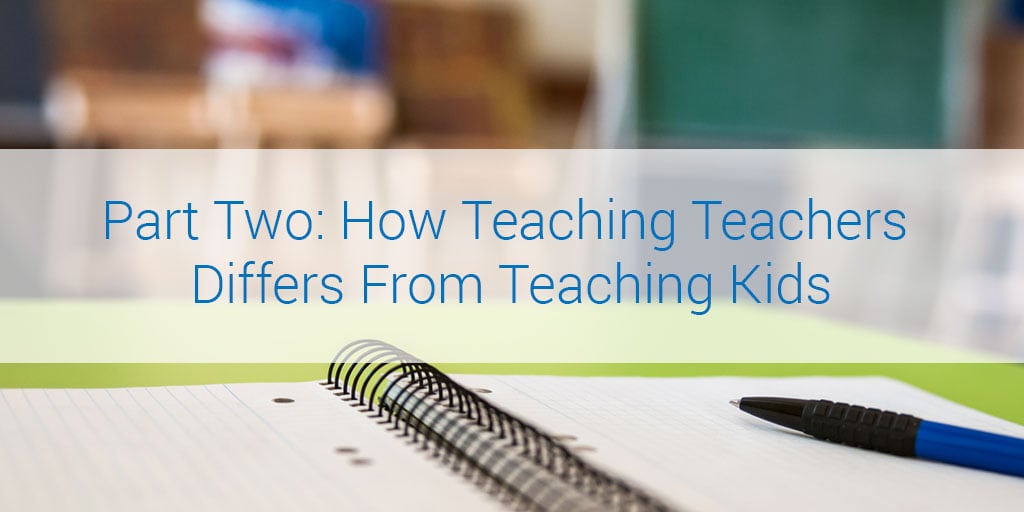
As professionally trained educators, we know there are best practices that we need to apply to teaching regardless of the age of the learner. Some of these universal practices were highlighted in our recent article in this series. In other ways, teaching adults is very different than working with students. If you are a person who works with adults in any kind of professional learning, you probably already know that there are some big differences between the two.
Here are some tips that I have found are important to keep in mind while planning and teaching adult learners:
- The “why” isn’t just important—it is essential: Relevance is important for students, but essential for adults. This doesn’t mean that adults need handouts of all the research supporting the instructional practice that is being taught, but it does mean that there has to be a reason it helps students in order for teachers to care. If it isn’t clear how it makes student learning and the classroom environment better, it will be hard for teachers to engage.
- And make sure you start with the “why”: Adult learners don’t have enough time. Because of this fact, they will check out early during a learning opportunity if there isn’t a clear reason for learning the material.
- Classroom procedures aren’t as important for adults: Adults can take care of their own needs and should be trusted to do so. I always find it funny when presenters tell the audience where the restrooms are—adults can surely figure that one out when they need to. On one hand, it is good modeling to go over procedures, but presenters should only review procedures that adults need, not the common sense ones.
- Adults crave differentiation: So many trainings are “one size fits all” for teachers. There is a basic, baseline knowledge that all teachers need, but for the most part, this is all we ever offer teachers. There should be options for learning based on need and data. One great solution to this that I have been a part of is the “Ed Camp” model. This is a great way to structure learning around topics that teachers want and need. They are grouped by similar skill level and interest so that teaching (and therefore learning) can be much easier and more productive.
- Adults learn from observing as much as being “taught”: I have presented to teachers before and pretty much 100% of the time I feel inadequate. In a group of teachers, they all know more about their grade level and content areas than I do. Instead of being a “teacher” and giving them direct instruction, I try to facilitate them getting out to other classrooms to observe. One idea for putting this in place within a school is a Pineapple Chart. These can be great moments of teaching and learning within a building, and can really drive professional conversations about what is going on.
- Don’t make adults do all the activities that kids do: It's key to model the type of teaching that you want to see, especially if you are teaching teachers. With that said, adults should not be treated in the same manner as little kids. It is definitely possible to train teachers in a strategy model—the strategy for them is making sure that they are the “student” in the situation. Sometimes it's important to do that, but more often than not, teachers really just want the information since they know how to go about implementing new techniques in their classroom.
- But if you do, apply the strategy to their learning rather than what the student is learning: An example of this could be a Kagan Strategy or something done with the MimioVote™ clicker. Teachers can learn the strategy by participating with the tool, but the content needs to be something they are learning as an adult. This can be really challenging for teachers of adult learning. I think most adults would prefer to learn efficiently about content if possible and not worry as much about the process. With some thought and effort, innovative instructional strategies can be applied across all different types of content.
Even though “teaching is teaching” in many respects, there are differences between adults and children that we must account for. I feel that too often presenters and professors miss these important differences and treat adults as though they are kids. I have found this can be an easy way to get teachers—especially teachers of secondary students—to disengage from the content from the start. By remembering some of these tips, maybe the adults will be as engaged as the students the next time you present.
If you missed the first part of this informative series, be sure to check it out on our blog.
For more insightful teaching tips, and to stay up to date with education technology trends, subscribe to the Educator blog today. And if you’re looking to connect with other educators and access great lesson content, consider joining MimioConnect™, our interactive teaching community.



